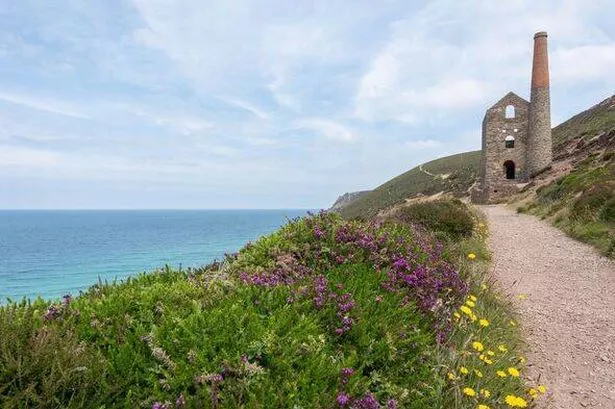Explore amazing Cornish landscapes where you can walk in the footsteps of Poldark’s Ross and Demelza this autumn — and stay at a huge historic country house where the drama was filmed
The period drama Poldark, which aired on the BBC from 2015 to 2019, captivated us with its stunning locations and compelling storyline, and the series, which starred Aidan Turner as Ross Poldark, was watched by eight million viewers per episode.
One of the highlights of the show was the breath-taking filming locations, and now, the National Trust is inviting fans to explore these sites this autumn and winter, as Cornwall celebrates a special Poldark anniversary.
Next year (2026) will mark 80 years since the publication of the first original Poldark novel, Demelza, which continues to enchant readers to this day.
The first TV adaptation of Winston Graham’s novels aired 50 years ago, running from 1975 until 1977, and it’s been 10 years since the acclaimed remake graced our screens in 2015, reports Cornwall Live.
One review of the 2015 series sums up the enthusiasm people had for Poldark: “This is the most artistic, photogenic, captivating series ever made. Besides an outstanding, lovely cast, the excellent performance by the lighting men, cameramen, director, scenery experts, colour specialists, costume creators, music score, and quality scriptwriters is beyond all expectations.
“Their outstanding teamwork often makes me freeze the image in order to better appreciate the beauty and magic of the shots: outside and inside. Breathtaking scenery and, extremely cosy, authentic cottages, and overwhelming, rich mansions—even the flower bouquets—are mind-blowing.
“So grateful to the whole crew, they made a genuine masterpiece. A treasure to cherish forever!”
The show’s spectacular filming locations span from the wild Tin Coast and vast sandy shores to the “ancient and atmospheric” Godolphin estate, which served as Trenwith in the 1975 Poldark series.
These breathtaking spots have attracted devoted fans from across the globe. The medieval gardens and historic house at Godolphin represent just one of the numerous National Trust sites that played a crucial role in bringing the Poldark tale to life.
The enduring phenomenon of “Poldark tourism” continues to fund essential conservation efforts throughout Cornwall, and visitor numbers have played a vital role in safeguarding threatened wildlife and habitats across the county.
Autumn presents an ideal opportunity to explore the striking landscapes that sparked the beloved saga. The cooler months offer a wonderful opportunity to explore Poldark country, as visitor numbers remain lower than during the summer peak, allowing you to truly savour the tranquillity that Cornwall provides.
Since its first appearance in 1946, Winston Graham’s “love letter to Cornwall”, the Poldark saga, has won hearts across the globe, whisking readers and viewers away to 18th-century Cornwall.
The dramatic vistas of mining heritage locations and rugged coastal cliffs took centre stage in the narrative when the original television adaptation was broadcast in 1975, and once more in 2015 when the reimagined series introduced an entirely new generation to Ross and Demelza’s Cornwall.
Poldark transformed into a worldwide phenomenon, motivating thousands to journey to Cornwall and discover the scenery they had witnessed on their screens.
By 2019, approximately 14% of Cornwall’s visitors were believed to have made the trip in some capacity due to Poldark, and this enthusiasm delivered a tourism windfall to the county whilst raising crucial funds for the conservation and maintenance of Cornwall’s natural and historic locations.
A significant portion of this support has been reinvested into preserving these remarkable landscapes for generations to come, with efforts along the Tin Coast concentrating on protecting natural areas and wildlife habitats. At West Wheal Owles, better known to Poldark fans as Wheal Leisure, conservation efforts have been put in place to protect the endangered Cornish choughs.
This area is now off-limits to the public, creating a safe haven for this iconic bird species.
For those who are fans of the 1975 TV series of Poldark, Godolphin will be familiar as it was the home of Francis Poldark and the fictional grand house, Trenwith.
Back when Godolphin was still a private residence, it served as a filming location. The National Trust bought the estate in 2007 and began extensive and careful conservation work to preserve the house for future generations.
In 2006, Godolphin was recognised as a UNESCO World Heritage site. Since then, the estate has become renowned for its historic gardens and 500 acres of protected parkland — and the house is available as a holiday let for most of the year.
Autumn is the ideal time to explore Poldark country with its quieter paths, sweeping sea views, and a feeling of stepping back into history.
From rugged clifftop walks and mining heritage trails to exploring historic houses and gardens, Cornwall’s National Trust sites offer visitors a chance to experience the landscape that inspired a legend.



